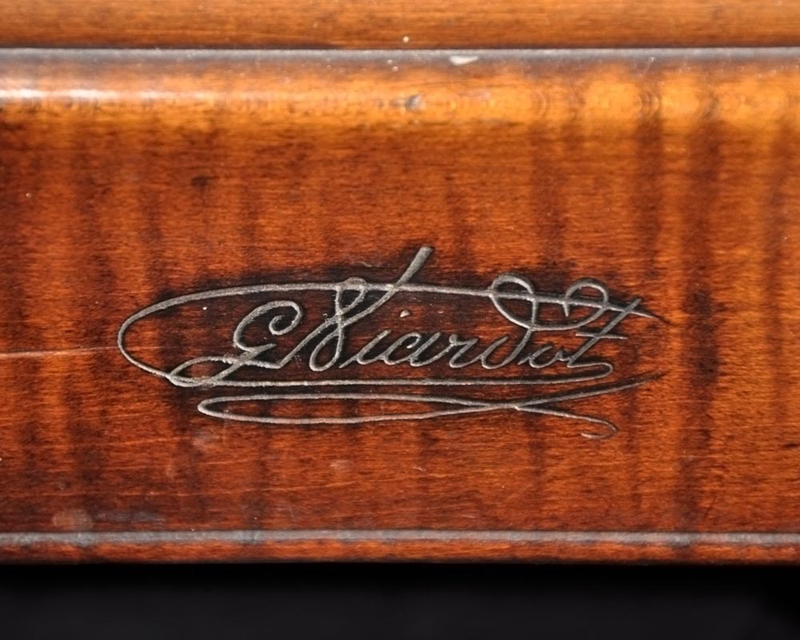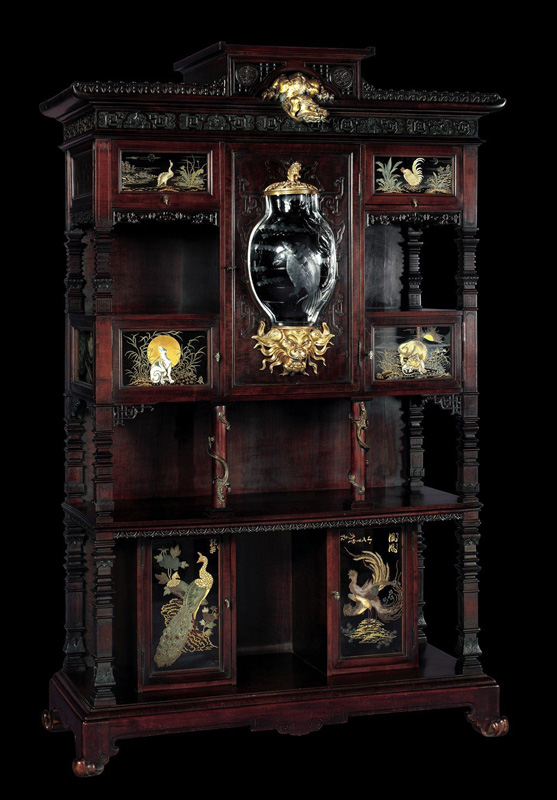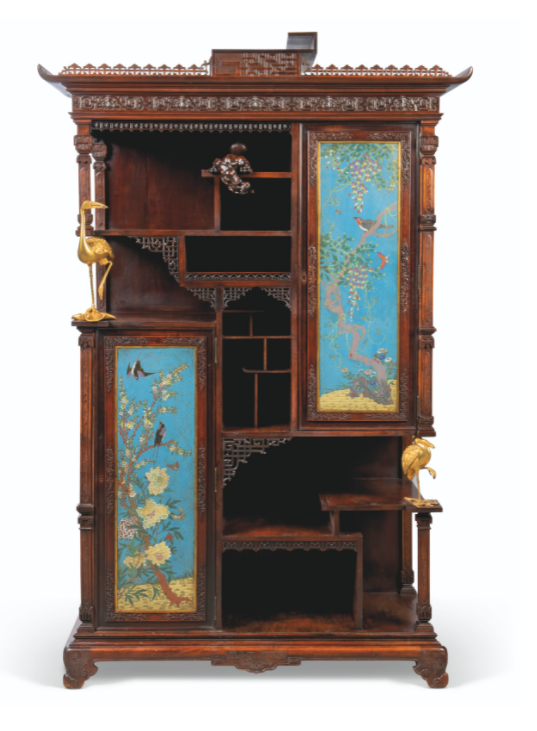The beginnings
Gabriel Viardot starts his career in the Jeanselme furniture workshop, furnisher of the Napoleon III court, before starting his own as a wood sculptor in 1849. He was then already the head of a small sculptors team even though he was only 19 years old.
Viardot Frères & Cie
He opens in 1853, a workshop and a wood furniture and decorative objets shop located on the 36 and 38 rue Rambuteau in Paris. At this time, Gabriel works with his brother, Alexandre-Laurent, under the company name “Viardot Frère & Cie”. Although, their collaboration was crowned with success and a bronze medal in the 1855 Great Exhibition, the two brothers separate in 1856. Alexandre-Laurent keeps the workshop and works under the name “viardot Ainé”, while Gabriel creates his own workshop “G.Viardot” on the 5 rue du Grand Chantier before moving again to the previous address. The two brothers have then a very similar production that we could qualify today by the “Forêt Noire” style.

Signature “G.Viardot”
The Chinese-Japanese inspiration
The 1870’s are considered as a pivot for the furniture maker, as he decides to dedicate himself to the Chinese-Japanese kind furniture, that he could observed in the 1867 Great Exhibition. He moves his workshop in 1874 in the 15 rue de Chaume, then in 1875 in the 3 rue des Archives.
His typical furniture production is sometimes made from lacquered panels sent directly from China or Japan, often adorned with Tonkin mother-of-pearls inlays, but always on an assembly made of sycamore which can sometimes be tainted. This exotical wood of light colour was very often mistaken with beech wood. The furniture were next lightened up with decorative bronzes.
The exhibitions and rewards
Gabriel Viardot participates to the numerous exhibitions that marked the artistic scene of the Second half of the 19th century. Each of his participations was crowned with success, indeed, he wins in the 1878 great Exhibition-the first where he exhibits in the section dedicated to the luxury furniture- a silver medal, then in Antwerp in 1885 and in Paris in 1889 and 1900, a gold one.
In the meantime, he also participates to the exhibitions of the Union Centrale des Arts Décoratifs where is unrivalled and jury member from 1884.
In addition, his work is described in these words in the Revue des Arts Décoratifs published in 1887 : “On the first exhibitors rank of sculpted furniture, we have to put Mr Viardot (Gabriel), unrivalled as jury member. Mr G. Viardot having drained all the awards possible, has not yet ran out the praises source. The very well executed pieces he exhibits are finished which easily explained the general success they meet. Inspired by the Chinese and Japanese arts, these furniture, adapted to the European use, are far superior, in their making, of the original ones, which very often only have a decorative interest and an assembly quite often defective; this adapation is that interesting, because Mr Viardot knows how to give its furniture a special character while keeping the Asiatic style.”
Medal dedicated to Viardot during the Exposition de l’Union Centrale des Arts Décoratifs in 1884
An established workshop
Very successful, the Viardot compagny employed in the middle of the 1880’s between 90 and 100 furniture makers and sculptors, trained by himself. He also employed around 20 subcrontractors. In 1885, after his participation to the Antwerp exhibition, he’s made Chevalier de la Légion d’honneur.
Important orders
The most famous client, bus also friend of Gabriel Viardot is Georges Clemenceau (1841-1929). This politician, admiror of the Asian continent, is also an important collector. He orders to his friend some furniture for his appartment in Paris, which became today a museum and that he occupied between 1895 and 1929. We cand find there a letters box, a bed, a cabinet, an original desk and a display furniture.
Clémence d’Ennery, passionated by the Chinese and Japanese arts, gathers in her private mansion on the avenue du Bois (today avenue Foch) an exceptional collection of Asiatic works of art. This jewel stayed the same since it was built in 1875, included the rooms where were exhibited the pieces collection. To exhibit them, Clémence d’Ennery had ordered to Viardot an important number of display furniture, still visible today.
Collaboration with L'Escalier de Cristal
Famous for its decorative arts, and later furniture production, L’Escalier de Cristal crossed the 19th century without losing its quality thanks to its successive owners’s know-how and ineniosity. It’s Henry and Georges Pannier, last owners of the maison, who had the idea from 1890 to extend the activity to the furniture production by making very good 18th century reproductions or Far East inspired furniture. For their making, the Pannier brothers collaborated with Parisian artists specialized in a luxurious and precise technical field, like Gabriel Viardot. Indeed, we can read in Henry Pannier’s books, where a part of the production was drawn, the name of Viardot associated to the naming of five furniture models.

Display furniture made in collaboration with L’Escalier de Cristal, circa 1890
Corning Museum of glass

Japanese furniture made in collaboration with L’Escalier de Cristal, circa 1890
Private collection
Closing of the workshop
Viardot organizes its succession on June, 17th 1890 by creating “G. Viardot et Cie”, business where he is associated with his son, Gabriel Léon Jules Viardot and his son-in-law Georges Isidore Jean Dupont, both were already working in the workshop. When he dies in 1904, they take the direction of the workshop, then in a very difficult financial position. The family decides to shut it and the business disapeared. Viardot’s company knew some difficulties in the end especially because of an important competition with other furniture makersof which the production is very close with Viardot’s one. But also because of news vogues such as the Art Nouveau.







